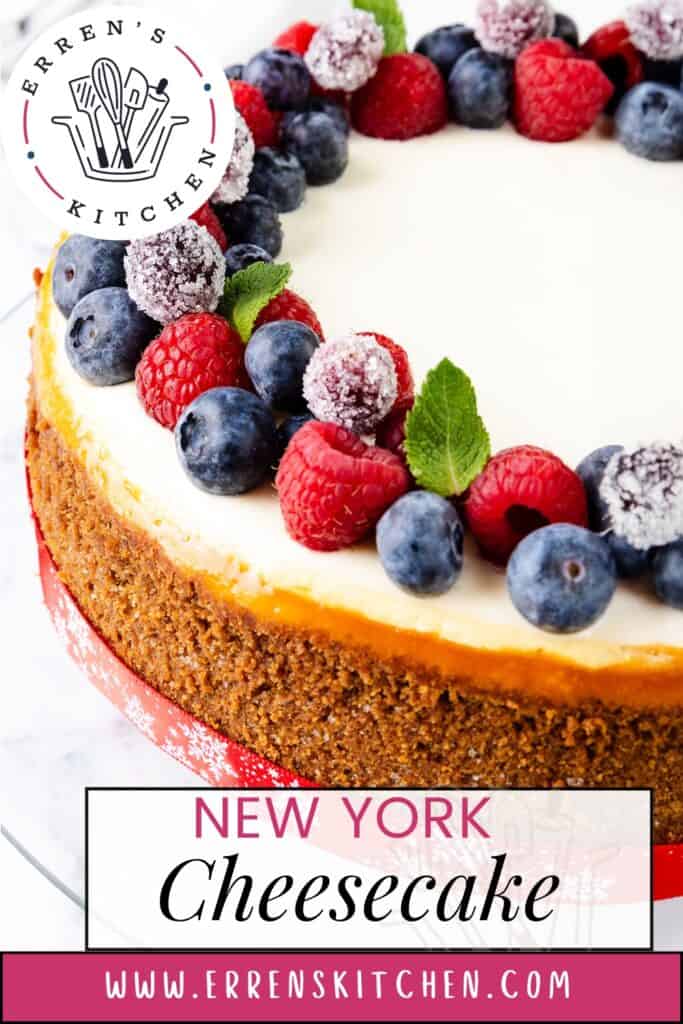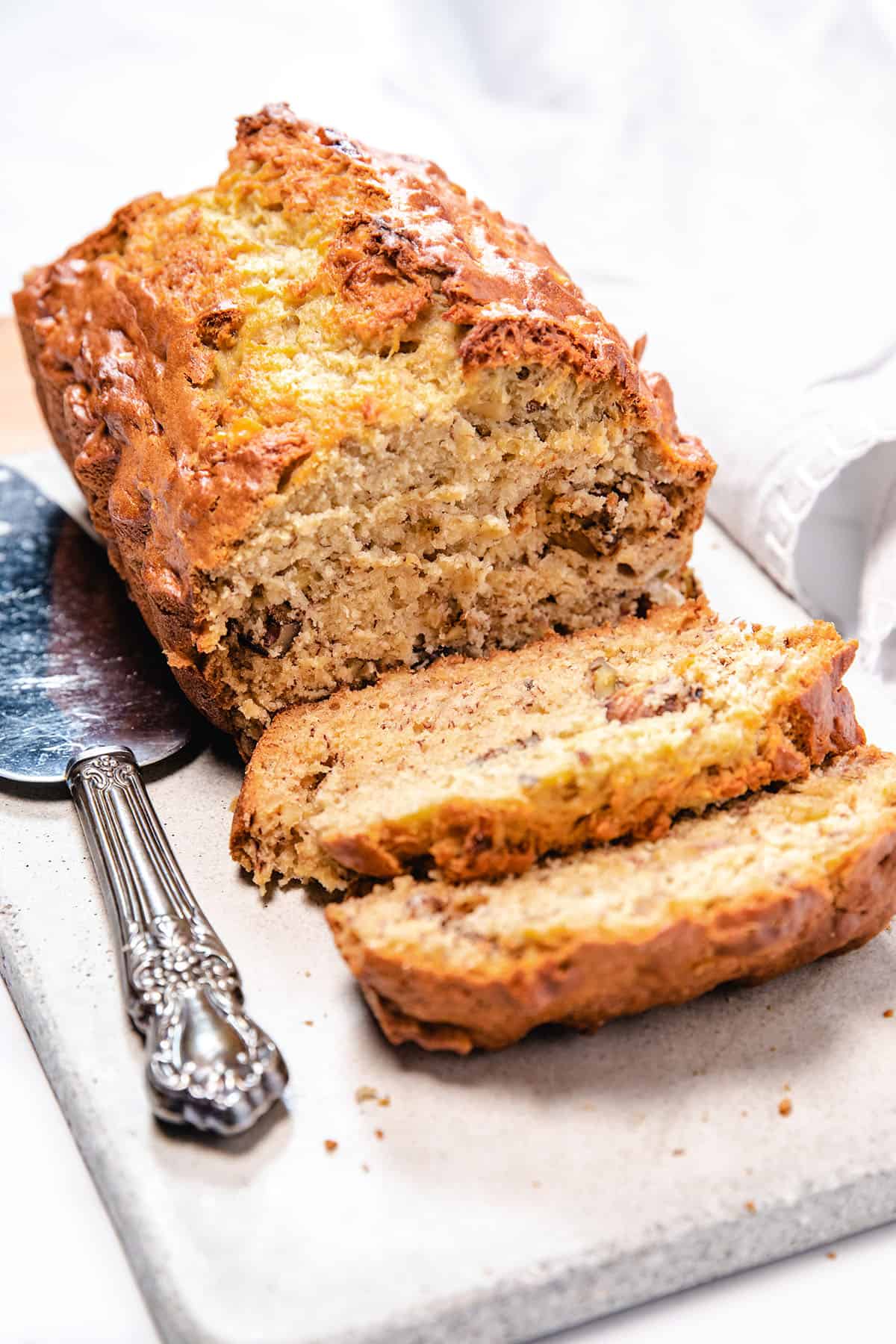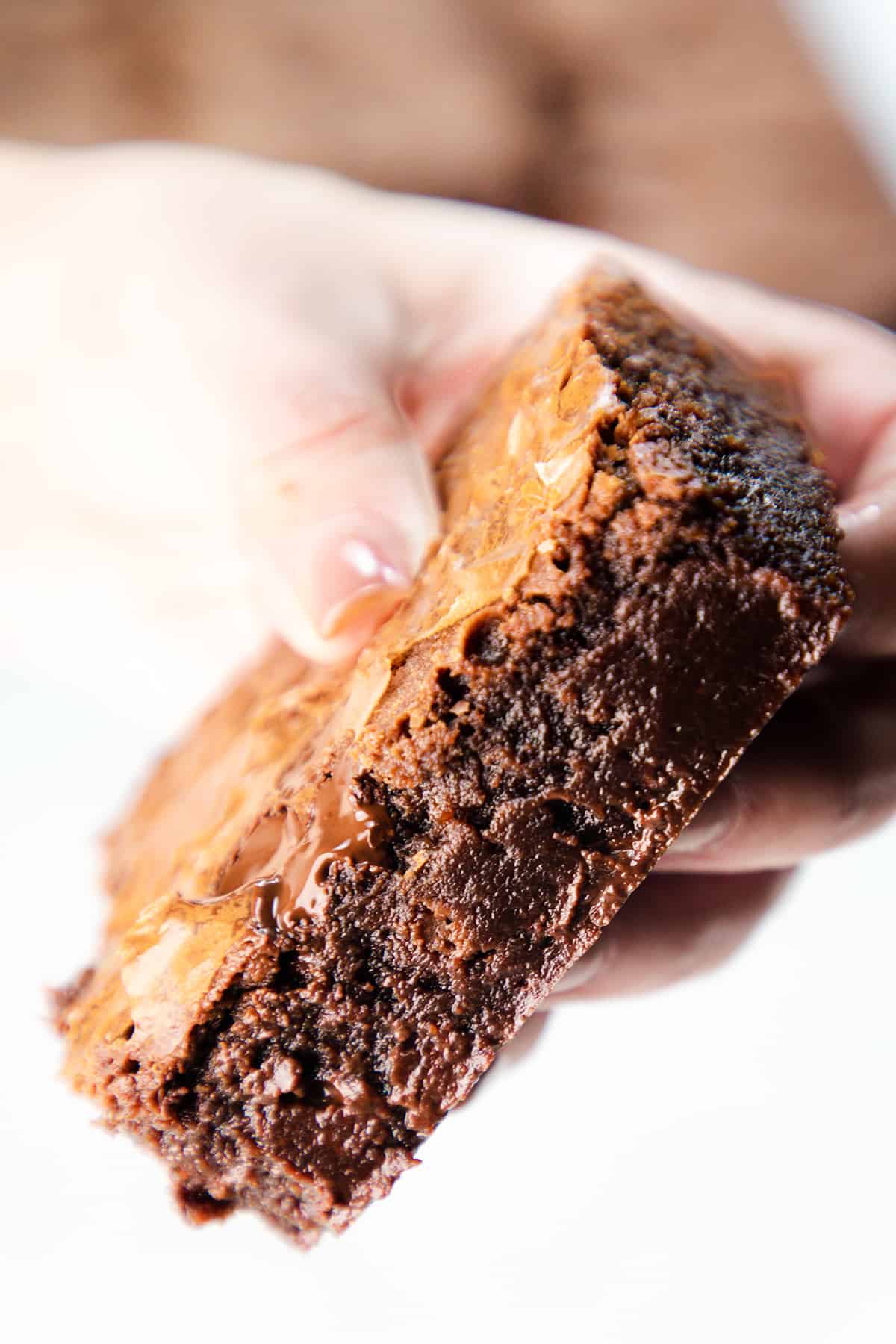
This site runs ads and generates income from affiliate links. Read my disclosure policy.
Get ready to wow with this foolproof recipe for a creamy, beautiful, crack-free New York-style cheesecake! Yes, even beginners can master this delightful dessert and impress!
Cheesecake is a luscious dessert made with creamy cream cheese filling that’s an American staple. For years, this New York Cheesecake has been a favorite in my family, and I can’t believe I’ve never shared it with you! With so many cheesecake recipes out there, I hesitated to post it, but I realized it’s time to focus on what matters most—sharing recipes I know you’ll love. So, here it is: my tried-and-true New York Cheesecake recipe, perfected over time and ready for you to enjoy.

Why This Recipe Works
- Luscious Texture: Creamy and smooth, with just enough tang from sour cream.
- Crack-Free Finish: Your cheesecake will look bakery-perfect with proper technique (and a water bath!).
- Versatile Topping Options: From fresh fruit to caramel drizzle, this cheesecake is a canvas for your creativity.

My No Water Bath Method
Don’t worry—no water bath is needed for this New York Cheesecake recipe! If you’ve been scared off by the idea of balancing your cheesecake pan over a tray of boiling water, you’re not alone. Thankfully, this recipe is designed to keep things simple while giving you that creamy, velvety texture you dream of!
By baking the cheesecake at a high temperature first and lowering it, we avoid needing a water bath to regulate heat. Plus, letting the cheesecake cool slowly in the oven prevents those dreaded cracks. And if you’re still nervous about the top looking perfect, the luscious sour cream topping will cover any tiny flaws, making your cheesecake look like it came from a bakery. With this recipe, you’ll have one less step to stress over and another reason to celebrate when you see the final result!
Ingredient Notes

- Graham Cracker Crumbs
- Best Choice: Go for finely crushed crumbs for a firm, even crust. Pre-made crumbs save time!
- Substitutions: Digestive biscuits or crushed vanilla wafers work beautifully.
- Where to Find: Check the baking aisle or grab whole crackers and crush them at home.
- Cream Cheese
- Best Choice: Full-fat block-style cream cheese is key for that rich texture and stability. Avoid whipped varieties.
- Substitutions: Neufchâtel cheese works, but the result will be slightly lighter.
- Sour Cream
- Best Choice: Use full-fat sour cream to keep your cheesecake firm, and set it as low fat will not give the stability needed.

Step By Step Instructions
You can find the full, printable recipe at the bottom of this post (click the button above), but you can read a summary with step-by-step instructions and photos for each step below.
For The Base
Preheat oven to 350°F (175°C).
Add 2 cups (200g) of graham cracker crumbs, ¼ cup (50g) sugar, and ½ cup (115g) melted butter to a mixing bowl. Mix until crumbs are coated and moistened.
Press the mixture into a 9-inch (23cm) springform pan. When pressing the crumb mixture into the pan, use the back of a spoon or the bottom of a measuring cup to evenly press it onto the bottom and slightly up the sides of the springform pan.
Be sure to pack it firmly—this helps create a sturdy crust that won’t crumble when you slice the cheesecake. A well-packed crust ensures every bite has that perfect balance of creamy filling and crisp, buttery crunch!

Bake for the base 10 minutes just to set the crust and give the cheesecake a stable base, then let it cool completely.

For The Filling
New York Cheesecake is a substantial cake that uses a full 2 lbs (900g) of cream cheese that’s been softened to room temperature. Beat the cream cheese until smooth, stopping from time to time to scrape the sides of the bowl.
Gradually add 1¼ cups (250g) sugar. I add it a little at a time and stop to scrape the bowl a couple of times. Make sure to get right to the bottom of the bowl. This will help avoid any lumps in the cheesecake.

Next, mix 1½ tbsp (12g) cornstarch, 2 ½ teaspoons vanilla extract, and ¼ teaspoon salt until fully incorporated. The cornstarch helps to create that velvety texture you love in a cheesecake while the vanilla and salt heighten the flavors

Reduce the mixer speed to low to avoid incorporating excess air into the eggs. Gradually add 4 large eggs and 1 egg yolk, one at a time, then blend in 1 cup (240g) of sour cream. Pause as needed to scrape down the sides of the bowl to ensure a smooth mixture.

Assemle & Bake
Pour the filling into the crust. Bake at 400°F (200°C) for 10 minutes, then reduce to 225°F (105°C) for 35 minutes. Turn off the oven and crack the door, letting the cheesecake cool gradually for 1 hour. This process helps prevent cracks without the use of a water bath.

Top & Serve
Mix 1 cup (240g) sour cream, ¼ cup (50g) sugar, and 1 tbsp lemon juice. Spread evenly over the cooled cheesecake. This topping adds a creamy lemon contrast to break up the richness of the filling.

Add fresh fruit as desired, slice, and serve.

Erren’s Top Tips
- Use room temperature ingredients: Ensure cream cheese, eggs, and sour cream are at room temperature for smooth mixing and creamy texture.
- Prep the springform pan: Use a 9-inch pan and check for leaks; wrap the outside with foil if necessary to prevent leakage.
- Firmly pack the crust: Use the bottom of a measuring cup to evenly press the graham cracker crust for a stable base.
- Avoid overmixing the filling: Beat cream cheese until fluffy, then mix on low speed after adding eggs to prevent incorporating too much air.
- Scrape the bowl frequently: Ensure there are no lumps in the batter by scraping down the sides and bottom of the bowl.
- Don’t skip cornstarch: It stabilizes the filling and helps prevent cracks.
- Follow the two-stage baking method: Bake at 400°F initially, then lower to 225°F to ensure even cooking and proper setting.
- Cool gradually in the oven: Turn off the oven and leave the door slightly ajar after baking to reduce the risk of cracking.
- Be mindful of overbaking: Overbaking dries out the cheesecake, leading to cracks. The center should still jiggle slightly when baking is finished, as it will firm up while cooling.
- Handle carefully while cooling: Avoid sudden temperature changes, such as placing the cheesecake in the fridge immediately after baking, which can cause cracks from rapid contraction.
- Whisk topping until smooth: Mix the sour cream topping thoroughly to eliminate lumps before spreading.
- Run a knife around the edges: After cooling to room temperature, loosen the cheesecake from the pan to prevent sticking and cracking.
- Chill thoroughly: Refrigerate for at least 6-8 hours or overnight for proper setting and enhanced flavor.
- Cut clean slices: Dip a sharp knife in hot water and wipe it clean between cuts for neat servings.
- Optional garnishes: Add fresh fruit, caramel, chocolate sauce, or whipped cream for an elegant finish.
Storage & Freezing Instructions ❄
Storage: Refrigerate your New York Cheesecake in an airtight container for up to 7 days.
Freezing: Wrap slices individually in plastic wrap, then foil. Freeze for up to 2 months. Thaw in the fridge overnight.

Rate This Recipe

Recipe
New York Cheesecake
Ingredients
Crust:
- 2 cups graham cracker crumbs
- ¼ cup sugar
- ½ cup melted butter
Filling:
- 2 pounds cream cheese (softened)
- 1¼ cups sugar
- 1½ tablespoons cornstarch
- 2½ teaspoons vanilla extract
- ¼ teaspoon salt
- 4 large eggs
- 1 egg yolk
- 1 cup sour cream
Topping:
- 1 cup sour cream
- ¼ cup sugar
- 1 tablespoon lemon juice
Instructions
Prepare the Crust:
- Preheat the oven to 350°F (175°C).
- Combine graham cracker crumbs, sugar, and melted butter in a bowl, mixing until well-blended and the crumbs are moist.
- Press the mixture firmly onto the bottom and up the sides of a 9-inch springform pan, ensuring it covers the sides evenly.
- Bake the crust for 10 minutes, then set it aside to cool while you prepare the filling.
Make the Filling:
- Increase the oven temperature to 400°F (200°C).
- In a large mixing bowl, beat the softened cream cheese on high speed using an electric mixer or stand mixer with a paddle attachment until light and fluffy.
- Gradually add 1¼ cups of sugar, a little at a time, beating well after each addition and scraping down the bowl as needed to ensure smoothness.
- Add the cornstarch, vanilla extract and blending until fully incorporated.
- Lower the speed of mixer to low and beat in the eggs one at a time on low speed, making sure each egg is fully mixed before adding the next. Then, add the egg yolk and mix thoroughly.
- On low speed, fold in half of the sour cream, blending until smooth.
- Pour the filling over the cooled crust, spreading it evenly.
- Place the cheesecake in the preheated oven and bake for 10 minutes.
- After 10 minutes, reduce the oven temperature to 225°F (105°C) and bake for an additional 35 minutes.
- Turn off the oven and let the cheesecake sit inside for 1 hour with the oven door cracked open slightly. This helps prevent cracks in the cheesecake as it cools gradually.
Prepare the Topping:
- While the cheesecake is cooling, mix together 1 cup of sour cream, 1/4 cup of sugar, and 1 tablespoon of lemon juice until smooth.
- After the cheesecake has been removed from the oven, spread the sour cream mixture evenly on top of the cheesecake.
Cool and Chill:
- Allow the cheesecake to cool completely to room temperature.
- Carefully run a spatula around the edges to loosen it from the pan,
Tips
Adjustments for a 12-Inch Tart Pan
Crust: The crust ingredients should remain the same but may need to be spread thinner to accommodate the larger surface area of the tart pan. Bake the crust as instructed (at 350°F/175°C for 10 minutes). Filling: Because the filling will be shallower in a tart pan, it will bake faster than in a 9-inch springform pan. Follow the same two-step baking method but reduce the times as follows: Initial Bake (400°F/200°C): Bake for 8 minutes instead of 10. Lower Temperature Bake (225°F/105°C): Bake for about 20–25 minutes instead of 35 minutes. Cooling in the Oven: After baking, turn off the oven and let the cheesecake cool inside with the door slightly ajar for 45 minutes to 1 hour. This gradual cooling process helps prevent cracks. Check for Doneness: The cheesecake is done when the edges are set, but the center still jiggles slightly when gently shaken. A shallower tart pan will result in faster setting, so keep an eye on it during baking. Topping and Chilling: Add the sour cream topping (if using) after the cheesecake cools, and chill for at least 6 hours or overnight to allow it to fully set.FAQs
How can I keep the base crisp longer?
Lightly beat an egg white and brush it over the crust before pre-baking. As the crust bakes, the egg white forms a thin, protective layer that helps keep moisture out.
What is the difference between New York cheesecake and regular cheesecake?
Regular cheesecake uses heavy cream and sour cream to thin the batter for a silky, creamy texture. New York cheesecake, however, uses more cream cheese, making it dense and rich. It is also topped with a sour cream topping. The extra cream cheese and topping are the key factors that make New York cheesecake unique.
Do I have to use a springform pan?
This recipe can be made in a 12-inch tart pan (removable sides are recommended). This will create a large cheesecake with a thinner filling, which is a good option for those who find the filling overly rich.
Why is my cheesecake cracking?
Overbaking or sudden temperature changes can cause cracks. Always cool gradually.
Can I make it gluten-free?
Yes, use gluten-free graham crackers for the crust.


















Leave a Reply